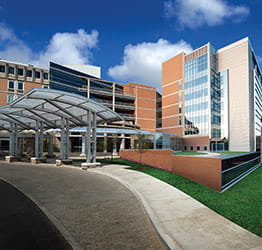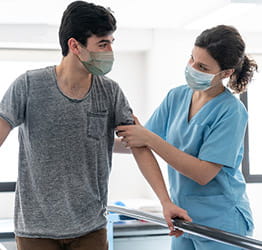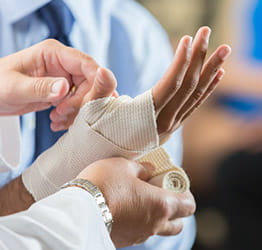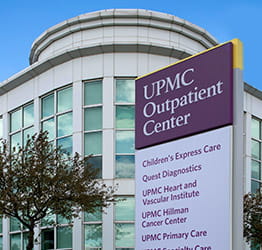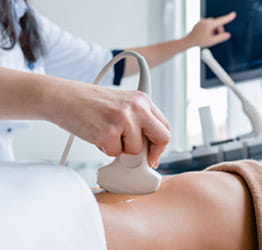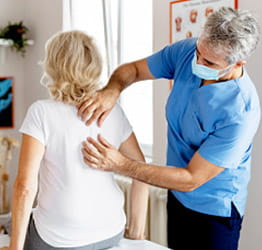When you need stroke care, seconds count. A fast diagnosis can make the difference between a complete recovery and permanent disability or death.
UPMC experts at our specialized stroke centers aim to meet or exceed national standards for the time taken to diagnose a stroke. Our team frequently provides a stroke diagnosis within 20 minutes or less of a patient’s arrival at the hospital, resulting in improved patient care and outcomes.
How to spot stroke B.E. F.A.S.T.
We recommend that everyone learn how to quickly spot a person having a stroke by remembering this easy acronym: B.E. F.A.S.T.
- Balance — Ask the person to stand up straight. Are they steady or do they feel dizzy or off-balance?
- Eyes — Ask if they’re experiencing double or blurry vision. Are they having trouble seeing clearly?
- Face drooping — Ask the person to smile. Is one side of their face drooping down or feeling numb?
- Arm weakness — Ask the person to raise their arms. Does one arm drift downward? Is it weak or numb?
- Speech difficulty — Ask the person to repeat a simple sentence, like "the sky is blue.” Are they able to understand? Did they repeat the sentence correctly? Is their speech slurred or hard to understand?
- Time to call 911 — If the person shows any of these symptoms – even if they go away – call 911 to get transportation to a hospital immediately.
Other signs to look out for are anything sudden, including:
- Confusion or trouble understanding.
- Numbness of an arm or leg.
- Severe headache with no known cause.
- Trouble seeing in one or both eyes.
- Trouble walking, dizziness, loss of balance or coordination.
Diagnostic Tests and Procedures We Offer
At UPMC, we take a comprehensive approach to stroke testing. As a result, our doctors can quickly determine whether a person is having a stroke and start treatment immediately.
Some of the tests we use to diagnose stroke include:
Neurological exam
A neurological exam is a noninvasive test that checks how well your brain and nervous system function. During a neurological exam, your healthcare provider will ask you to answer questions and perform movements or tasks that test your mental status, balance, reflexes, movement, muscle tone, hearing, walking, and thinking abilities.
National Institutes of Health Stroke Scale (NIHSS)
Doctors use the NIHSS to assess symptoms and stroke severity.
The assessment involves a series of scored tests performed during a physical exam to assess language, eye movement, weakness, and level of awareness. The total score is used to guide treatment decisions and predict prognosis.
Brain imaging tests
Your doctor may order brain imaging tests, including:
- CT scan — A test that creates images of your brain and is used to diagnose brain bleeds, large strokes, or other types of brain injuries.
- MRI — Uses a combination of large magnets, radio frequencies, and a computer to produce detailed images of your brain.
Tests to show blood flow and blood clots
Tests to check for problems with blood flow, bleeding, or blood clots include:
- Carotid artery ultrasound — A noninvasive imaging test that uses sound waves to show blockages in your carotid arteries, which are located on either side of your neck and supply blood to your brain. Also called Doppler ultrasound.
- CT or MR angiogram — Also known as arteriography or an arteriogram, this test uses x-rays or magnets and a special contrast dye to look for problems with the blood vessels in your brain, including blockages causing stroke or aneurysm.
Other tests for stroke
Your doctor may order other tests, including:
- Blood tests — To check for signs of blood clots or other problems.
- Echocardiogram (Echo) — A noninvasive test that uses sound waves to create images of your heart.
- Electrocardiogram (EKG) — A noninvasive test to look for an abnormal heart rhythm that may increase your risk of blood clots.
Why Choose UPMC for Stroke Care?
When you choose UPMC for stroke care, you will receive:
- Access to world-class neuroscience expertise — UPMC is among the world’s best multidisciplinary stroke centers. When surgery is necessary, our neurointerventional and neurosurgery teams are experienced in advanced treatments, including traditional and investigational approaches that are not widely available.
- A full range of treatment options — We offer nonsurgical and minimally invasive stroke care, as well as traditional open surgical procedures, allowing us to effectively treat all types of strokes while reducing your risk of complications.
- Multidisciplinary care — We partner with neurology, cardiology, radiology, and rehabilitation specialists, as well as other medical experts, to provide complete care that optimizes your recovery and quality of life.
By UPMC Editorial Staff. Last reviewed on 2025-10-23.





